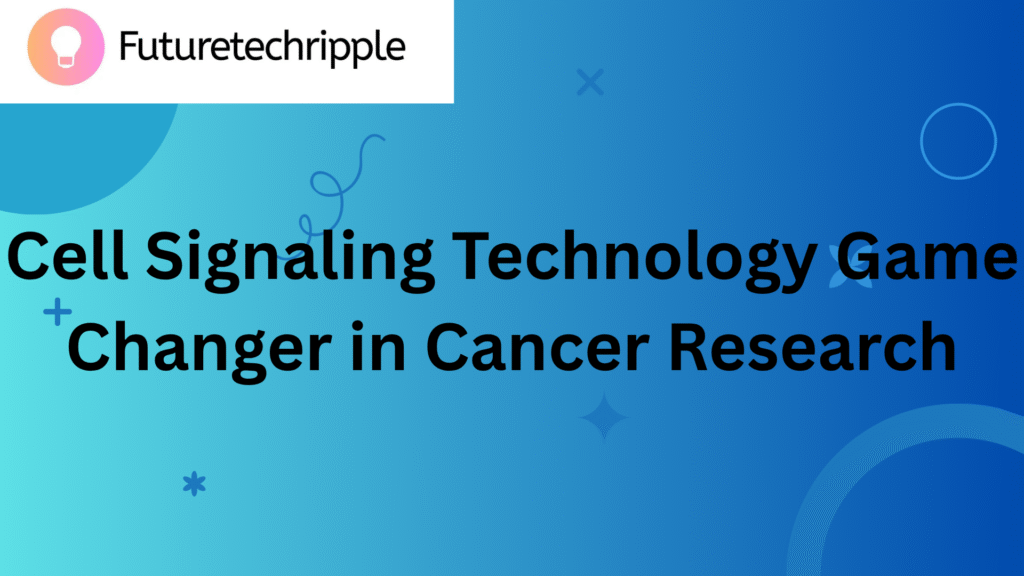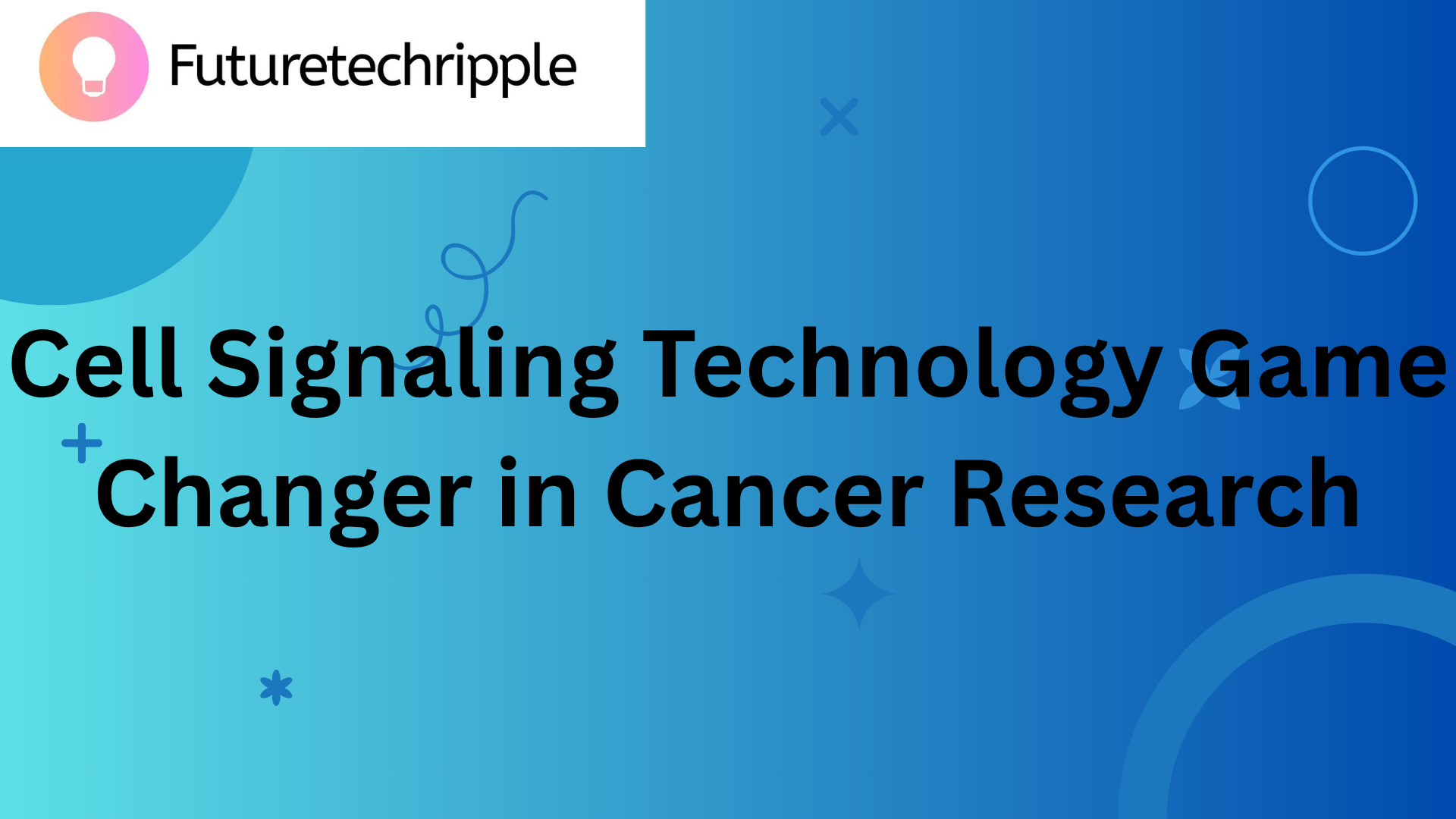Table of Contents
Introduction.
Cancer is still one of the hardest diseases to deal with, but scientists are finding new ways to tackle it. Cell signaling technology is one of the most exciting new fields in recent years. It is convert the most basic things we know about cancer and how to treat it.
Signals are a complex chemical lingo that informs cells when to grow, divide, heal, or die. Cells in the body talk to each other by sending signals. But this way of talking doesn’t work in cancer. Cells start sending the incorrect signals or not responding to the proper ones, which causes tumors to develop and spread.
Researchers are finding the fundamental causes of cancer and making better, more tailored therapies by understanding and using cell signaling. This technology is changing the game in the fight against cancer, from individualized treatments to the newest tests.
In this post, we’ll talk about how Cell Signaling Technology works, why it’s important for cancer research, and how it will change the future of cancer treatment.

What is cell signaling technology and how does it work?
Cell signaling technology is the name for the procedure and methods used to find out how cells communicate. This link is vital for every component of the body, from development and healing to the immune system and even the spread of cancer. With better technology, scientists can now find and manipulate these signals. This helps them understand more about diseases and design treatments that function better, especially in the case of cancer research.
Learning the Basics of How Cells Talk to Each Other
Cells are always “talking” to one other at the heart of life. Hormones, neurotransmitters, and proteins are some of the chemicals that send messages between cells. A cell sends a signal to another cell, which gets the message through a receptor, which is like a lock and key. This starts a chain reaction in the receiving cell that tells it what to do, such divide, move, die, or start another process.
Important Parts of Signal Transduction
stimulus transduction is the process by which a cell turns an outside stimulus into a response that works. The main parts that are involved are:
Hormones, growth factors, and other signaling molecules called ligands start the procedure.
Receptors are proteins that are either on the outside of a cell or within it that attach to the ligand.
Calcium ions and cAMP are two examples of second messengers that transport the signal inside the cell.
A signaling cascade is a series of protein activations, mainly kinases, that lead to a final event, such cell division or gene expression.
This complicated yet well-organized process makes sure that cells work properly. If it goes wrong, it can cause illnesses like cancer.
How Cell Signaling Affects How Cells Act
Cell Signaling Technology has a direct effect on how cells operate. It can tell a cell to:
Grow or split (which is crucial for tissue growth and, if not controlled, cancer)
If it is hurt, it will kill itself (a process called apoptosis).
Get to a different section of the body (this is vital for mending wounds or cancer spreading)
Start immunological responses to fight infections or cancer.
When signaling pathways alter, it can be due of mutations, toxins from outside the cell, or sickness. The cell can start to act in a strange way. Scientists are employing Cell Signaling Technology to retain an eye on these changes and figure out how to fix or stop bad signals, mostly when it comes to treating cancer.
Why is cell signaling so important for cancer research?
Cell signaling is a big element of how cancer develops, grows, and spreads. At its heart, cancer is a disease of poor communication. The cell gets the incorrect information, which causes it to grow too quickly or live longer than it should. That’s why cancer researchers are now harnessing cell signaling technologies to understand how to interpret and manipulate these signals.
The Link Between Strange Signaling and Tumor Growth
Cells that are fine acquire signals that tell them whether to grow, divide, or rest. Cancer cells, on the other hand, don’t have to obey these instructions. Cells can keep proliferating and form tumors if their signaling goes wrong, which is generally due of genetic issues.
A faulty gene could urge a cell to “keep growing” all the time, even when it shouldn’t. Some cancer cells also send out their own signals, which helps them grow in a loop. These erroneous instructions make cancer grow quickly, last a long time, and kill.
How pathways that don’t work right make drugs less effective
One of the worst things about treating cancer is when cancer cells stop responding to treatment. This is called drug resistance. A lot of the time, this happens because the signaling pathways in the cells adapt or find a way around the problem.
If a drug stops one pathway, for instance, the cancer may discover another way to live. This “signal rewiring” enables tumors grow even when they are undergoing a lot of therapy, which makes it hard to stay in remission for a long period.
If scientists know how these signaling changes function, they can create better medicines that block more than one route or estimate how the cancer will try to fight back.
Focusing on Signaling Pathways for Effective Treatments
What is the good news? Scientists may now go target these damaged communication networks directly because of today’s better cell signaling technology.
These are called targeted therapy. They target certain proteins or pathways that cancer cells require to stay alive. Here are several examples:
1. HER2 blockers for breast cancer
2. EGFR inhibitors are used to treat lung cancer.
3. BRAF inhibitors for melanoma
Chemotherapy kills all fast-growing cells, while targeted medications don’t. They don’t look at all the signaling problems that cancer cells cause. This indicates that the treatment will work better and have fewer side effects.
New Ways to Treat Cancer That Work
Cell signaling technology has made it possible for cancer treatment to be more personalized. Scientists may at this time make medications that directly affect how cancer cells talk to one other. This makes treatments more effective, tailored, and less dengrous. Here are some of the most important ways new technology is changing the way we battle cancer:
Targeted Therapies Based on Signaling Pathways
Targeted therapy is one of the major discoveries in cancer treatment. These medications are made to block certain cell signaling pathways that don’t work right in cancer cells. Targeted treatments don’t kill all quickly proliferating cells as regular chemotherapy does. Instead, they focus on the specific chemicals that are making a tumor grow.
For instance:
In a few types of breast cancer, the HER2 protein tells cells to “grow” all the time. Trastuzumab and other drugs inhibit this signal.
In a few types of lung cancer, EGFR mutations cause cells to expand out of control. That chain responce can be stopped by targeted EGFR inhibitors.
These medications frequently perform better and have fewer adverse effects than regular chemo because they target the cancer cells’ aberrant signals.
New developments in immunotherapy and cell signaling
Cell signaling is at the heart of immunotherapy, which has become a groundbreaking way to treat cancer.
Our immune system already employs signals to find and kill threats. But cancer is tricky; it may “turn off” immunological signals or even order immune cells to stop working. Scientists can use cell signaling technologies to find out exactly how cancer achieves this and how to switch the immune system back on.
For instance, checkpoint inhibitors block signals that tell immune cells not to target cancer cells.
CAR-T cell treatment changes a person’s T-cells so that they can find cancer signals and attack them more strongly.
These methods work because they have a lot of knowledge about how cancer and immune cells “talk” to one other. They are saving lives when other therapies have failed.
Using Signaling Data to Make Cancer Treatments More Personal
Even with the same type of sickness, there is no such thing as a perfect tumor. That’s why personalized medicine is getting more and more popular. Cell signaling data is a significant part of how it works.
Doctors can identify if signaling pathways are active or mutated by looking at a patient’s tumor at the molecular level. This information helps individuals decide:
- Which medications will work best
- If a patient is likely to react to immunotherapy
- How the tumor could change or fight therapy over time
For instance, if a test shows that the PI3K/AKT pathway is to blame for a tumor, physicians can give the patient a drug that operates on that pathway. If the signaling data doesn’t identify any mutations that can be acted on, a wider therapy may be require.
This method helps eliminate the “trial and error” of typical therapies and gives each patient better, more personalized care.
Important cell signaling technologies that are driving new ideas
Scientists now have better tools that help them comprehend and change the complicated signaling networks inside cells. This is because technology changes so fastly. Not only are these new discoveries helping us learn more about how cancer behaves, but they are also making treatments better and more specific.
Using CRISPR and gene editing to study signaling
Researchers are utilizing CRISPR to transform how they look at Cell Signaling Technology. Researchers may employ this gene-editing method to modify or switch off genes that are part of signaling networks. This helps us understand better how these genes work in the growth of cancer.
For instance:
Researchers can “knock out” a gene and watch how the cell’s signaling changes.
They can also modify genes in ways that induce cancer and look at how signaling changes. This gives them new methods to develop medications.
Scientists can use CRISPR to modify the sections of cells that convey signals to other cells. This allows them build fake ailments, see how pharmaceuticals operate, and even design remedies that correct damaged genes. It’s the best of exact science.
Seeing Signaling Events in Real Time
Scientists could only see how cells communicate with each other through photographs acquired with a microscope that didn’t move. But with contemporary imaging technology, they can observe signals in living cells in real time.
This is a big deal because:
It illustrates how cells react to changes fast and in a flexible way.
It makes patterns and times that weren’t obvious previously clearer.
Researchers who study cancer can see how tumor cells respond to drugs or how immune cells operate during immunotherapy in real time.. You can view the whole tale when you watch a movie instead of simply gazing at one frame.
AI and bioinformatics in the signal pathway Mapping
There are hundreds of proteins and connections in cell signaling networks, which makes them very complicated. That’s where bioinformatics and AI (artificial intelligence) join in.
Scientists can do the following with these tools:
Look at huge amounts of data from imaging, gene expression, and protein activities.
Make guesses on how signaling pathways will act in different situations.
Find hidden patterns and potential drug targets faster than ever before.
AI also helps make therapy more individualized by comparing a patient’s signaling profile to thousands of others and identifying the medicines that are most likely to succeed. In sum, it’s taking too much biological data and translating it into useful medical information.
Issues and What to Do Next
Cell signaling technology has gone a long way, but there are still certain issues that need to be fixed. To deal with the complexity of tumors and remain ahead of treatment resistance, we will need fresh plans, collaboration, and the ability to modify when necessary.
Overcoming Tumor Resistance and Heterogeneity
Even in the same tumor, each cancer cell is different in some way. This makes it challenging to find treatments that work on each types of cancer cells. Treatment could help one area of the tumor, but another component keeps getting bigger.
As I said before, medication resistance frequently comes from alterations in signaling pathways. Cancer cells are smart; they change, send messages in different ways, and stay alive.
Researchers are working on the following to get beyond this:
- Therapies that inhibit various pathways at once on several targets.
- Changing treatment plans that change as the tumor does.
- Tools for monitoring that find early symptoms of resistance.
New Trends in Signal Modulation Techniques
New treatments don’t merely block signals; they also make them better. Scientists are presently looking into:
Small molecule modulators that change signals instead of turning them off.
PROTACs, or proteolysis-targeting chimeras, tell cells to break down bad proteins.
Drugs made of RNA that change gene expression at the signaling level.
These technologies provide us more control and fewer side effects by fixing what’s wrong in cancer cells while keeping healthy signals.
The Future of Precision Oncology Through Signaling
The end aim is precision oncology, which means therapies that are tailored to each person, can foresee what will happen, and are proactive. Cell Signaling Technology data is very important here since it
Helping to create treatments depending on the specific signaling profile of a tumor.
Figuring out how a patient will react to a medicine before they even start using it.
Making it possible to find cancer sooner by looking for signaling problems.
As technology keeps getting better, cell signaling will be at the center of a future where cancer treatment is no longer reactive but planned, focused, and very successful.
Conclusion.
Cell signaling technology is a big stride forward in how we understand and treat cancer, not merely a scientific accomplishment. Scientists might be able to make smarter, more targeted, and more successful drugs than ever before by studying how cells speak to one other and where those discussions go awry.
We now have incredible tools to attack cancer at its root, such tailored therapies and testing that happen in real time. There are still problems like tumors being complicated and medications not working, but the progress that has been done so far is really encouraging.
Cell Signaling Technology will become an important part of cancer treatment in the future as research continues to grow. This will change illnesses that used to be lethal into diseases that can be remedy or even cured. In sum, it’s transforming the way we learn about cancer and the way we fight it.





